Polar Encyclopædia
PENGUINS
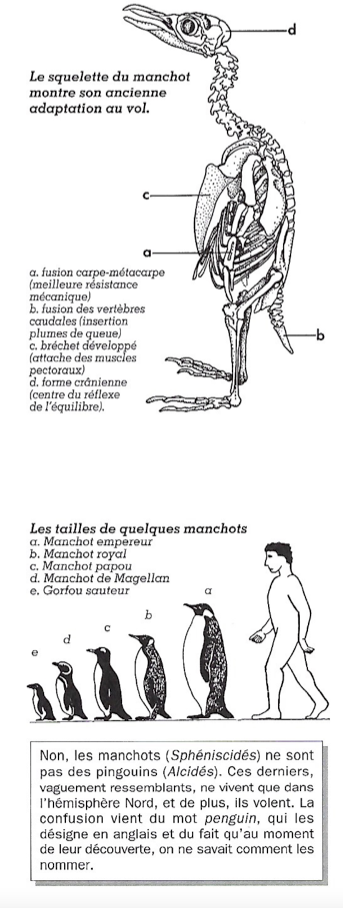
Penguins are southern hemisphere birds that lived there even before the ice cap formed. Their ancestor - a relative of petrels - did fly, but changes in morphology occurred 45 to 65 million years ago. The wings were reduced and transformed into fins, and the body was adapted to the marine environment. Fossils of the largest penguin (Anthropornis grows 1.8 m.) were found on Seymour Island. Penguins are Spheniscidae. There are 18 species, 8 of which are unique to the Antarctic regions (the Emperor and Adelie are even confined to the periphery of the continent.); the others nest in subantarctic to subtropical regions and their distribution is in concentric circles around Antarctica, depending on the surrounding water temperatures.
In the water, penguins swim with their fins, their legs serving as rudders. They sometimes jump out of the water like porpoises, probably to breathe, but also, probably, to avoid the appearance of turbulence that would slow down their "top speed" (48 km/h). They manage to climb in one leap to a shoreline nearly 2 meters high. On land, penguins walk upright, although they sometimes slide on their stomachs (toboganning). Penguins dive to search for food (over 400 m for the emperor), holding their breath for several minutes.
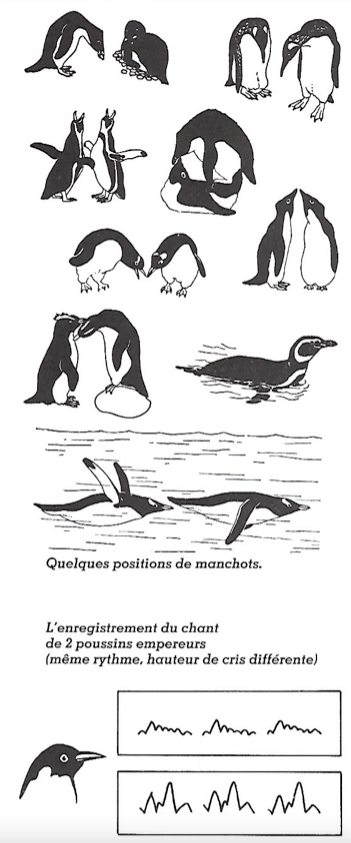
Penguins feed on plankton, fish, and cephalopods, depending on the species and the season. To remove excess salt from their food, the kidneys are not enough; like other seabirds, they have "salt glands" above the eye sockets and leading out through an excretory channel.
After their meal, they shake their head to chase the "beak drop". Penguins observe long periods of fasting when on land to breed and during molting.
All nest on land, or on the ice: some in burrows they dig or under boulders, the others in the open, on a rudimentary nest. Only the emperor and the royal penguin do not have a nest. After a period of fattening at sea, the males find their nests on land, sometimes a hundred kilometers away, where the females join them. These penguins are monogamous and we often see the same couples forming. Penguins lay one or two eggs, but only one chick is usually kept. The parents incubate alternately and take turns to feed their chick according to a "calendar" specific to the species. They regurgitate the food that the chick comes to take in their crop (a pouch under the throat where they store food)
Penguins form huge colonies with sometimes several thousand pairs, often of different species, in one location. The chicks are often gathered in crèches, which limits predation and improves the thermoregulation of the young, i.e. the ability of the body to remain at a desired temperature. Calls, plumage, but also postures or head movements are used to communicate (parade, defense of territory, etc.). Each chick has its own call, recognized by the parents despite the large size of the colonies.
The only predators of penguins are killer whales, seals, and leopard seals, or, on land, skuas, jaegers, and giant petrels, which attack the weakest. Man has exploited penguins for their eggs, their feathers and especially their oil (the pressed bodies were used as fuel under seal or whale fat pots). They are currently protected.
Nevertheless, studies have shown that large temperature variations in the past have greatly disturbed penguin populations, which may suggest that the current climate disruption may have an effect on their ability to both feed and find habitat, due to poor sea ice conditions.
The Magellanic penguin
The Magellanic penguin (Spheniscus magellanicus)
The most northerly. Lays two eggs in a deep burrow (3 m) dug in the sand or a grassy slope (Incubation: 28 days). The burrow allows him to regulate his temperature, as well in winter as in summer, because he risks to suffer from the heat. Feeds on cuttlefish and fish.
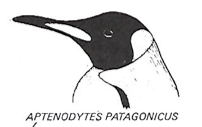
The royal penguin
The royal penguin (Aptenodytes patagonicus)
Lays an egg between the end of November and February, twice in three years (Incubation: 55 days). No nest, and lives on the beaches. It feeds at sea, on fish and squid. It dives regularly until 200 m of depth. It is recognizable by the spoon-shaped spot on its ear, which differentiates it from the emperor penguin.
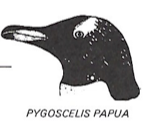
Papuan penguin
Papuan penguin (Pygoscelis papua)
Lays two eggs in September/October on a nest of rocks sometimes covered with plants or feathers (Incubation: 35 days). Feeds mostly on fish, sometimes on crustaceans and squid. Measures between 75 and 80 cm, but it is not the smallest of the penguins. They nest in very noisy and smelly rookeries.
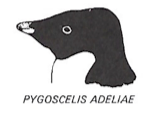
The Adelie penguin
The Adelie penguin (Pygoscelis adeliae)
Rather aggressive. Climbs rocks and icy slopes. Lays two eggs on a nest of rocks (Incubation: 36 days). Feeds mainly on krill. The dive usually lasts a little more than two minutes. Its biggest predator is the leopard seal, which lurks around the coast to catch it when it emerges from the water.
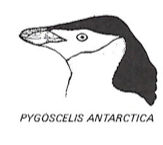
The chinstrap penguin
The chinstrap penguin (Pygoscelis antarctica)
Lays two eggs on a gravel nest. It is aggressive and sometimes steals the nests of Adélie penguins, which live in the same habitat. Likes to settle on icebergs. Feeds on krill and some fish.
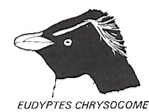
The golden gorfou (or Macaroni)
The golden gorfou (or Macaroni) (Eudyptes chrysolophus)
Lays two eggs on a nest of stones, but usually only the second one, bigger than the first, will hatch. Feeds on krill and fish. Like many penguins, they swallow stones that allow them to dive deeper.
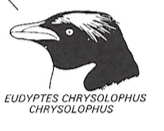
The jumping gorfou
The jumping gorfou (Eudyptes chrysocome)
Leaps over scree instead of going around it on its belly as other species do. Lays two eggs, of which only one will hatch, in a nest strongly protected by the parents. Feeds on krill and fish. It can be distinguished from the golden gorfou by the color of its eyes and the shape of its yellow egrets.
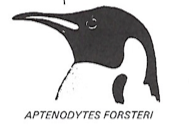
The emperor penguin
The emperor penguin (Aptenodytes forsterr)
The largest of the penguins (up to 130 cm for an adult). The only species to reproduce in the heart of winter, on the Antarctic (-30 °C). Lay its single egg on its legs, under a fold of skin. The male fasts for more than three months during the incubation period and loses half his weight; he then travels up to 300 km on the ice pack to reach the sea. Feeds on krill, squid and fish.
For more details :
- Les manchots (Tollu)
- Guide des oiseaux et mammifères (Prévost/Mougin)
- Pour la Science n° 30
- La Recherche n° 119
- L'Antarctique (Trad. Avérous/Mazin)
- Géo n°5 88, 146
- Atlas de la vie sauvage (Ed. René Malherbe)
Support the project with a donation
The Polar POD expedition is one of the stamp of the pioners, a human adventure coupled with a technological challenge, an oceanographic exploration never before carried out which will mark a milestone in the discovery of the oceans.
Thank you for your support !